
2. SUMMARIES OF REMARKS, PRESENTATIONS, AND SITE VISIT
Opening Remarks
Mr. Masahide Shima (Managing Director of ECCJ) opened the workshop. In his opening remark, he expressed great pleasure in welcoming all the participants. He pointed out the objectives and encouraged everyone to participate actively in the discussion and to come up with actionable outputs of the ECAP 20 workshop.

Opening remark by
Mr. Shima from ECCJ
Mr. Christopher De Guzman Zamora (representative of ACE) warmly welcomed all the delegates to the workshop. He expressed his gratitude to METI and ECCJ for the continuous support given to ACE and AMSs. He acknowledged the good takeaways from the ECAP workshops which support ASEAN to achieve its energy intensity reduction.

Opening remark by
Mr. Zamora from ACE
Mr. Abdul Salam Haji Wahab (representative of trainee) delivered his opening remarks on behalf of all trainees / participants. He thanked METI, ECCJ and ACE for their efforts in facilitating the workshop. Lastly, he wished everyone can gain a valuable knowledge that they can share back to each home country.
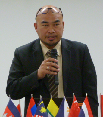
Opening remark by
Mr. Wahab from Burnei
Keynote Lecture
Mr. Norihiro Kimura (Deputy Director, International Affairs Office, Energy Efficiency and Renewable Energy Department, Agency for National Resources and Energy (ANRE), METI) delivered his lecture on EE&C policies in Japan. The comprehensive presentation introduced the “EE&C policy framework”, “measures and energy-saving potential by sector”, “comparative overview of the EE&C Act and the building energy-efficiency act”, and “Energy Supply/Demand Structure toward CO2 Emission Reduction Target in 2030”.

Keynote lecture
by Mr. Kimura from METI
Mr. Christopher De Guzman Zamora (the representative of ACE) presented the EE&C Latest Policy and Legal Framework in ASEAN. His presentation highlighted the following information.
- Under the APAEC Phase I:2016-2020 Energy Efficiency and Conservation Program Area, ASEAN has achieved 24.4% energy intensity reduction, based on 2005 levels (exceeded the target of 20% reduction by 2020) .
- The introduction of the development of APAEC Phase II: 2021-2025 which will focus on promoting energy transition, enhancing resilience and inclusive growth.
- In the latest AEA in 2019, ASEAN has received two (2) submissions for ZEB Ready subcategory. However, based on the decision of Board of Judges (BOJ) there was no winner under the subcategory. Therefore, this ECAP 20 was designed to also enhance and improve the guideline submission of ZEB Ready subcategory under AEA.
Lectures by Japanese Experts
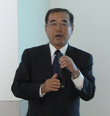
Lecture by Dr. Ushio
Dr. Yoshitaka Ushio (ECCJ senior advisor) presented the current status on GBCs/BECs in Japan. His presentation highlighted the following items.
- Overview of the energy conservation law and related regulation on buildings.
- Energy Manager and EC guideline which are the key factors to promote EC.
- Policy and measures for green building in Japan, which initiated by different two relevant ministries, including CASBEE, EC law and ZEB assessment.
- CASBEE by MLIT and ZEB assessment by METI on non-residential building
Benchmark system for non-residential buildings

Lecture by Mr. Ito
Mr. Kunio Ito (Manager, Consumer Division, Sustainable Open Innovation Initiative (SII)) gave his lecture on the expanded definition of ZEB in Japan with aims to produce more ZEB cases to large scale buildings in Japan. The following information were highlighted.
- Nowadays, the number of ZEBs with total floor area of 10,000 meter square or more is only 14 cases out of 304 cases in total.
- Therefore in disseminating ZEBs in large scale building, one of the remedies is that ZEB definition to be expanded to introduce ZEZ Oriented on top of ZEZ Ready, Nearly ZEB.

Lecture by Mr. Yamamoto
Mr. Katsuhiko Yamamoto (Manager, Business Alliance Support Center, ECCJ/Jase-W) delivered his lecture on “ZEB Family Concept and International Standardization of ZEB.” He stated the following items.
- JASE-W currently focus on ZEB, CHP, Waste-to-Energy and Geothermal
- ZEB can be realized by step-by-step approach from ZEB-Ready.
- “ZEB Ready” buildings can be designed, constructed and operated by use of not only advanced technologies but also other measures such as measurement, verification and management.
- Japan has been proposing the standardization of the ZEB family in ISO TC205 WG2 (Design of energy-efficient buildings).
- JASE-W is also promoting ZEZ family concept by way of holding joint workshops in Malaysia and others.
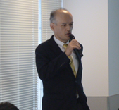
Lecture by Mr.Oosugi
Mr. Seiji Oosugi (LIXIL Corporation, Manager, Sash Products Development Group, LHT ASIA Market Development Dept.) delivered his lecture on “the energy efficient building envelope for dissemination and promotion of ZEB”. The following information were highlighted.
- Windows with high heat insulation & airtightness can save energy
- 3 considerations in choosing suitable windows are as follows:
ⅰ. Surrounding environment of the construction site
ⅱ. Seasonal wind direction based on weather data
iii. Wind speed by building height
- The combination of the high-performance sash and high-performance glass is the key to improve insulation performance
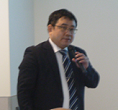
Lecture by Mr. Kuzuoaka
Dr. Yoshikazu Kuzuoka (Panasonic Corporation, Intelligence & Liaison Department, Life Solutions Company) delivered his lecture on the energy efficient lighting.
The following information were highlighted.
- Concept of Human Centric Lighting (HCL)
- Flexibility in ZEB design with consideration of human wellness (e.g. circadian lighting design)
- WELL Building standard TM (WELL Certification) is an evaluation system aiming at creation of better living environment by adding viewpoint of health and well-being of human to design, construction and operation of space
- Evaluation index for feeling of brightness of space (Feu) .
- Smart street lighting project in Jakarta which successfully saved energy and cost significantly
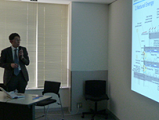
Lecture by Mr. Inoue
Mr. Kiwamu Inoue (Daikin Industries, Public Relation Dept. Tokyo Office) delivered his lecture on the energy efficient air conditioner. His presentation highlighted the following items:
- AC solutions are realized with an extensive line up for all types of needs including those for energy-savings, the environment, comfort, peace-of-mind, safety and health.
- Inverter can reduce energy of AC operation by effectively controlling motor speed.
- Specification of AC varies with climate and characteristics of region.
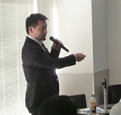
Lecture by Mr. Sato
Dr. Hideki Sato (Sanken Setsubi Kogyo, Senior Research Engineer, Tsukuba-Mirai Technology Center) delivered his lecture on the energy efficient air conditioner. His presentation highlighted the following.
- For new building, well-coordinated construction planning in the early stage is necessary for ZEB development.
- Regular monitoring & evaluation of energy consumption is necessary in the operation stage of ZEB.
Site Visit
・Sanken Setsubi Kogyo Co., Ltd. – Tsukuba-Mirai Technology Center
・Shinryo Corporation – Headquarter Building
・Kajima Corporation – KT Building
A one and half day tour was arranged for the participants.
Tsukuba-Mirai Technology Center of Sanken Setsubi Kogyo Co., Ltd.
It is categorized as the net ZEB building and it won many awards for the ZEB achievements
The energy efficient technologies, shown to all participants are as follows:
a. Outer skin performance
i. Exterior thermal insulation
ii. Low-e pair glass
b. Air-conditioning System
i. Decoupled sensible and latent cooling
ii. Direct use of renewable energies
c. Electric Equipment and Lighting System
i. High efficiency lighting
ii. Daylight control and zone control of lighting
iii. High efficiency transformer

Sanken Setsubi Kogyo Co., Ltd. – Tsukuba-Mirai Technology Center in Tsukuba Mirai City
Headquarter Building of Shinryo Corporation
It is categorized as the ZEB oriented building. The office was renovated to renew the 40-year old building to improve the energy efficiency. Its renovation project acquired environmental performance evaluation, ”CASBEE-building renovation planning (S-class)”.
The improvement made through the renovation and energy conservation efforts implemented are as follows:
a. Thermal load reduction
b. Adopting high-efficient equipment
c. Use of natural light
d. Minimum use of AC
e. Highly efficient operation of equipment including:
i. AC system with separated type of dehumidification and cooling
ii. AC system with underfloor air distribution
iii. Decentralized individual ACs
KT Building of Kajima Corporation
It is categorized as the ZEB ready building.
It was certified as first case of BELS as the domestic office in line with the energy-saving

Shinryo Corporation – Headquarter Building in Yotsuya, Shinjuku-ku
calculation method accordingly with the revised EE&C Act in 2016FY. The highest-level S-rank was achieved in CASBEE third-party certification.
The improvement made through the renovation and energy conservation efforts implemented are as follows:
- Reduce solar radiation by effect of outer frame
- Creating brightness of office at night with glass blocks
- Rationalized building construction by reducing 50% of labor cost
- Efficient lighting plan and zoning system
- Use of smart light controlling system
- Use of energy saving AC control system

Kajima Corporation – KT Building in Motoakasaka, Minato-ku
Country Reports
Participants presented Country Reports included the following topics:
– Status of development, implementation, and future task of BECs/GBCs in their respective countries.
– Proposals to refine the AEA (increase of entries, improvement of criteria and judging procedure, etc.).
Brunei Darussalam
Mr. Abdul Salam Haji Abdul Wahab (Head of Energy Efficiency & Conservation, Ministry of Energy) explained following items.
● The launching of green building rating system for Brunei Darussalam, ‘Brunei Accredited Green Unified Seal’ (BAGUS) in March 2016 with a mandated Energy Efficiency Index (EEI) of 175 kilowatt hours per square meter (kWh/m2) per year for office building.
● Brunei Darussalam via the Authority of Building Control and Construction Industry (ABCI), Ministry of Development has launched the Different Abilities Design Guidelines for building in December 2018.
● Brunei Darussalam will increase its participation in the ASEAN Energy Awards through the newly established platform of National Energy Manager in all Ministries.
Cambodia
Mr. Munyphakdey Koet (Chief Officer, Ministry of Mines & Energy, MME) explained following items.
● EE Targets: reduce energy demand by 20% in 2035, energy intensity reduction to 65% in 2035 compared to 2010.
● Final Workshops and Dissemination Draft of the National Energy Efficiency Policy, dated 21st March 2018, supported by the EU Energy Initiative Partnership Dialogue Facility (EUEI PDF)
Lao PDR
Mr. Khammanh Sopraseurth (Head of Division, Institute of Renewable Energy Promotion, Ministry of Energy and Mines) explained following items.
● The National target of Lao DPR is the reduction of national energy demand by 10% (reduce energy intensity). The targeted areas namely, industry, residential, building & office and transportation
● Problem and key challenges of EE&C development are namely,
i. Insufficient database and information of all types of building
ii. Many relates tools are underway of development
iii. Guideline and mechanism on high energy efficiency building are necessary to develop
iv. No reference tools for designing EE building
v. Poor public awareness on EE&C
Malaysia
Mr. Zainal Abidin Mohamed Nadhir (Assistant Director, Energy Commission Malaysia) explained following items.
● Malaysian Standards: (MS)1525:2019 – Energy Efficiency and Use Of Renewable Energy For Non-residential Buildings – Code of Practice gives guidance on the efficient use of energy including the application of RE in new and existing non-residential building.
● Malaysia developed the National Energy Award in order to recognize the best implemented practices by Malaysian companies and organizations through the adoption of energy efficiency, management and renewable energy solutions in driving the country’s sustainable energy sector.
● Malaysia had signed a Memorandum of Understanding (MoU) with Japan between Sustainable Energy Development Authority (SEDA) and JASE-World
Myanmar
Ms. Aye Kay Khaing Soe (Deputy Director, Energy Efficiency & Conservation Department, Ministry of Industry) explained following items.
●There is bilateral cooperation between Japan and Myanmar to support the preparation of the energy conservation handbook
●The provisional of Myanmar National Building Code (MNBC) which cover extensive issues on buildings, including energy efficiency matters.
●Myanmar has proposal to refine the ASEAN Energy Award which include,
i. To discuss detailed criteria and scores and scoring system (Support to Malaysia)
ii. To use excel sheet in scoring system
iii. Malaysia’s ranking system (discuss within AMS representatives)
Philippines
Mr. Artemio Ponesto Habitan (Division Chief, Department of Energy) explained following items.
● The guidelines on energy conserving design of building will be revise in 2020 and the building energy code will be developed in 2020 under EU-ASEP technical assistance program
● Philippines has suggested following points to increase the submission of AEA, .
i. EE policy should include Renewable Energy Technology for self-use on top of Energy Efficient Technologies to increase ZEB Participants/Users;
ii. Increase promotion of ZEB as a new principle in new building construction, and in existing and retrofit buildings.
Singapore
Mr. Eng Shyan Toh (Director, Building and Construction Authority (BCA)) explained following items.
● Singapore is now focusing on the implementation of Super Low energy (SLE) buildings’ program which aims to spearhead the next lap in Singapore’s green building movement to push for more energy-efficient solutions in a cost-effective manner.
● For the next lap, Singapore will be focusing on two (2) key focus areas namely:
i. Reducing energy demand through super low energy programme and increasing energy supply through solar deployment
ii. Sustaining optimum performance of well-designed green buildings through good quality facilities management
Thailand
Ms. Chalermluk Jitrumpueng (Professional Engineer, Department of Alternative Energy Development and Efficiency (DEDE), Ministry of Energy) explained following items.
● The new 2019 version of BEC Ministerial Regulations include the enforcement of new or retrofitted buildings with using area more than 2,000 m2 in 9 building types
● The implementation of BEC regulation includes following points;,
i. Revise energy conservation act and set standard for energy consumption on building design plan (Enforcement is expected to start in 2020)
ii. Training and certified “Energy Conservation Building Auditor”
iii. Educate stakeholders such as Institute, building design engineers & architects
iv. Promote energy efficiency building design (enforced gov-buildings, voluntary private buildings
v. Improve database system for EE&C building construction materials & appliances
vi. Promote BEC Award to public
● Thailand has considered the proposed changes in the scoring system of AEA and would like the participants to comment as follow:
i. In considering that the existing rule doesn’t allow the judge to score the reports submitted by his/her own country, it is noted that the proposed ranking system, using ranking average, may cause bias amongst countries.
ii. In addition, it should be noted that the ranking system may not reflect the true quality of each report if number of judges is not enough. This effect is most prominent when each report is of similar level in quality.
iii. To solve this problem, EE&C SSN should study the possibilities of using online system to encourage participation by all countries. This may ultimately eliminate the need for physical meeting which helps reduce cost and promotes participation.
Vietnam
Mr. Dinh Chinh Loi (Official, Ministry of Construction (MOC)), in his Country Report, explained the following items.
● GBC are implemented on a voluntary basis in Viet Nam.
● The Viet Nam Green Building Council, a foreign NGO started to develop the LOTUS set of green building rating tools in 2010.
● LOTUS tools, endorsed by the World GBC, have been developed based on other international GB rating tools (LEED, Green Star, BREEAM, Green Mark, etc.) but customized to suit Viet Nam context.
● The barriers and challenges of Implementation of BEC includes the administrative/legal, technical and market challenges.
Ms. Dynta Munardy Trishana (Technical Officer, Asean Centre for Energy (ACE)), presented the ASEAN GBC and AEA status. The following items were highlighted.
● ASEAN GBC Rating Tools: The rating tools are Brunei Accredited Green Unified Seal (BAGUS) of Brunei Darussalam, Greenship of Indonesia, Green Building Index (GBI) and Malaysian Carbon Reduction and Environment Sustainability Tool (MyCREST), of Malaysia, Building for Ecologically Responsive Design Excellence (BERDE) of Philippines, Thai Green Building Index (TGBI) of Thailand, BCA Green Mark of Singapore and LOTUS of Vietnam. Cambodia, Lao PDR and Myanmar are at various stages of development of codes for building energy efficiency.
● The report of 2019 AEA results especially on ZEB special submission category, with no winners for 2019 and the suggestion to enhance the guideline of the submission.
Brief Summary of the Small Group Discussions
Small group discussions were held to discuss the following points;
i. How to apply the lessons of the 2019 AEA result
ii. Countermeasures to promote more AEA submission
<Group composition>
Group A: *Brunei Darussalam, Cambodia, Lao PDR, Malaysia, Philippines (1), Singapore (1), ACE (1), advisor: Mr. Tanaka of ECCJ
Group B: Myanmar, *Philippines (2), Singapore (2), Thailand, Vietnam, ACE (2)
advisor: Mr. Ushio of ECCJ
(*: Leader, elected a secretariat in charge of reporting in each group)

Scenes at small group discussions (group A and group B)
Summary and Way Forward by ACE after the Discussion
ACE provided with the following information regarding the result of AEA 2019 and issues on ZEB Ready sub-category:
a. There were two (2) submissions received from Malaysia and Singapore
b. Board of judges (BOJ) decided to have no winner
c. BOJ suggested to further clarify and fine-tune the guidelines and definition of special submission, especially on ZEB Ready sub-category.
Discussion Results
The key takeaways and recommendations from the small group discussions are as follows:
a. To keep the current ASEAN Award categories for next year (2020)
b. To study following ideas
i. Criteria:
• ZEB Oriented > 30% energy saving (RE excluded)
• ZEB Ready > 40% energy saving (RE excluded)
• Nearly ZEB > 60% energy saving include RE
• Net ZEB 100% or more energy saving include RE
ii. Gross Floor Area (GFA): 2,000 square meters and above
iii. Project should at least have 1-year operational data to be eligible to submit under ZEB category
c. To study following countermeasures to increase submission and enhance AEA procedures
i. AMS (government) can help to promote ZEB concept by adopting policy and regulation
ii. Consider using online platform for BOJ who cannot attend the final judging meeting (decision by EE&C focal Points)
iii. Request for nominated judges for AEA to be familiar with the judging criteria based on ECAP workshop agreement (to be briefed by their own country representative who attended ECAP)
d. To consider elevating ZEB toa major category from sub-category in AEA’s Energy Efficient Building from Year 2021 onwards
